- The Impactful Benefits of AI in Agriculture
- AI Enables Better Decision-Making Process
- Addresses Shortage of Labour
- AI Helps in Cost Savings
- Promotes Sustainable Farming Practices
- Transforms Agricultural Supply Chains
- What are the Applications of Artificial Intelligence in Agriculture?
- 1. Weather Prediction
- 2. Soil and Crop Monitoring in Real-Time
- 3. Using Drones for Data Collection
- 4. Precision Farming
- 5. AI-Powered Robots
- 6. AI-Enabled Surveillance Systems
- Real-World Examples of AI in Agriculture
- Plantix
- MAAN
- Agrobot
- John Deere
- Essential AI Components Driving Agricultural Innovation
- 1. Artificial Neural Networks (ANNs)
- 2. Bayesian Networks (BNs)
- 3. Convolutional Neural Networks (CNNs)
- 4. Recurrent Neural Networks (RNNs)
- 5. Decision Trees and Random Forests
- 6. Support Vector Machines (SVMs)
- 7. Fuzzy Logic Systems
- 8. Deep Reinforcement Learning
- 9. Graph Neural Networks (GNNs)
- 10. Evolutionary Algorithms
- Must-Have Agritech Solutions to Transform Your Business
- Farm Management System
- Aerial Imaging
- Robotics and Automation
- Vertical and Indoor Farming
- Why your Business Needs Agriculture Custom Software Development
- Automated Processes
- Better Planning
- Increase Nutritional Value
- Cost Reduction
- Meet Sustainable Goals
- Step-by-Step Approach to Leveraging AI in Agriculture
- Identify the Problem Areas
- Data Collection
- Choose the Right AI Technology
- Train AI Models
- Implement AI Solutions
- Monitor and Optimize
- Scalability and Expansion
- Continuous Feedback Loop
- Overcoming Agricultural Challenges with AI-Driven Solutions
- 1. Data Availability and Quality
- 2. High Initial Investment
- 3. Lack of Technical Expertise
- 4. Integration with Existing Systems
- 5. Data Privacy and Security Concerns
- The Next Frontier in Agriculture: AI-Powered Innovations
- Revolutionize Your Agriculture with Appinventiv's AI Solutions
- FAQs
Agriculture has always been the backbone of the economy, providing essential food and resources. However, as the global demand for food rises, agricultural businesses face the challenge of scaling operations efficiently while minimizing environmental impact.
Thanks to tech innovations like Artificial Intelligence that facilitate industry with high-end functionalities like demand forecasting and predictive analytics to meet these demands without compromising sustainability or productivity.
Besides demand forecasting, AI offers transformative benefits, from optimizing crop management and improving supply chain efficiency to predicting market trends precisely.
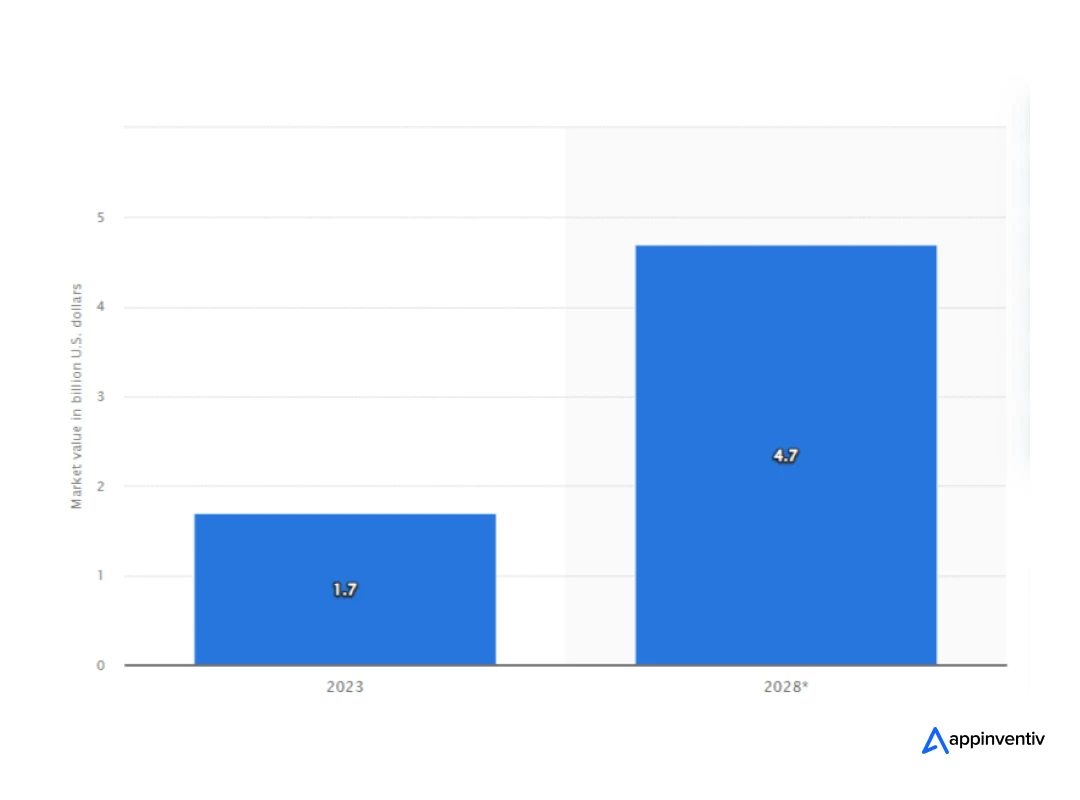
Furthermore, according to Statista, the global agriculture market’s artificial intelligence value was approximately $1.7 billion in 2023, with projections indicating it will rise to around $4.7 billion by 2028.
As mentioned above, the potential of AI in agriculture presents significant opportunities for businesses to invest in innovative solutions. By leveraging AI, agricultural companies can make data-driven decisions, streamline operations, and ensure sustainable growth, paving the way for a smarter, more profitable future.
So, without further delay, let’s delve into the role of AI in agriculture, its development approach, standout features, and beyond.
The Impactful Benefits of AI in Agriculture
Adopting AI in agritech may seem daunting to farmers, especially those unfamiliar with advanced technology. However, the advantages it brings to agriculture cannot be overlooked. Far from being limited to the digital realm, AI offers tangible solutions that significantly enhance agricultural processes.
Let’s explore the advantages of AI in agriculture, from promoting sustainable farming and transforming supply chains to enhancing decision-making and addressing issues like labor shortages and cost inefficiencies.
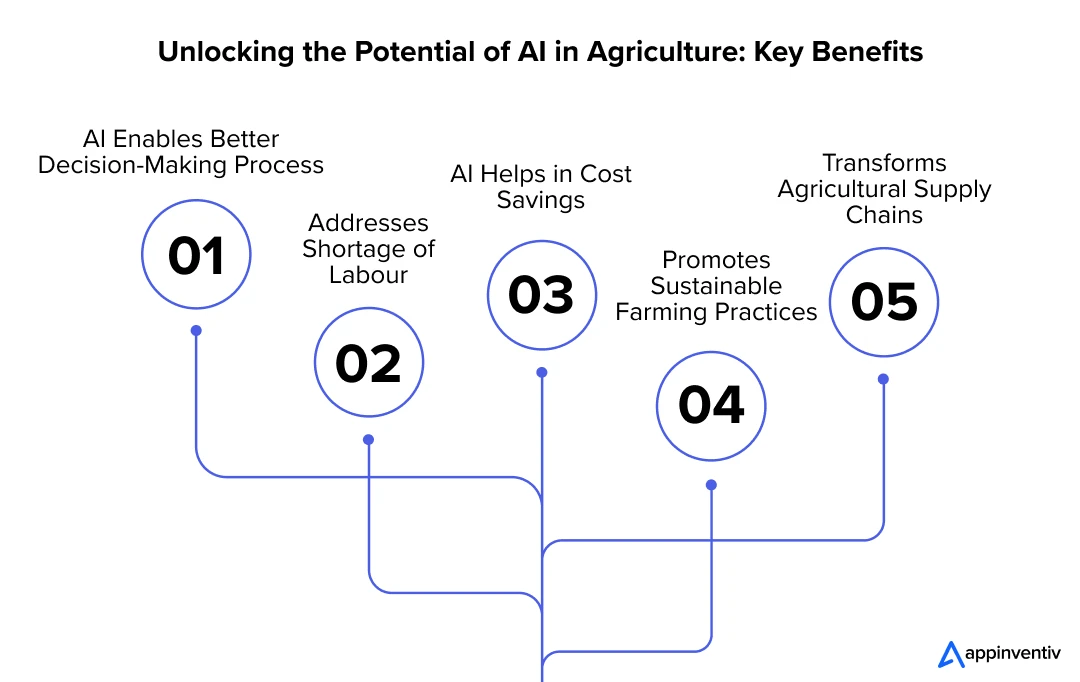
AI Enables Better Decision-Making Process
With predictive analytics, farmers can now collect and process data easily and do it faster with AI. Forecasting prices, analyzing market demand, and determining the optimal time for sowing and harvesting are some of the crucial tasks which farmers can solve with AI.
AI implementation in agriculture can also help gather soil health insights, monitor the weather, provide fertilizer recommendations and track the readiness of a particular produce. All these factors enable the farmers to make better decisions at every stage of their agriculture process.
Bonus Read- Breaking the Digital Frontier in Agriculture with Mobile Apps
Addresses Shortage of Labour
Working on agricultural land is hard, and agriculture, as an industry, has been consistently experiencing this. Labour shortage in this industry is nothing new. However, this common agricultural problem can be solved with the help of automation.
Smart irrigation systems, driverless tractors, smart fertilizing systems, vertical farming software, smart spraying, and AI-based robots for sowing and harvesting are some of the best examples of AI in agriculture that show how farmers can get their crop management process done without hiring manual labor. Compared to humans, AI-driven tools are faster and provide more accurate results.
AI Helps in Cost Savings
Precision agriculture can help farmers grow crops with fewer resources, thus leading to cost savings. Artificial Intelligence powers this kind of agriculture and has now become a big thing in agriculture. By combining the best soil management practices and effective data management practices, farmers can minimize their spending and maximize yields. AI farming helps identify areas needing fertilization, irrigation, or pesticide treatment.
For instance, vertical agriculture helps to increase crop production, thus minimizing the utilization of resources. The result is better harvest quality, lesser use of pesticides, significant cost savings, and higher profits.
Promotes Sustainable Farming Practices
AI in farming empowers farmers to make data-driven decisions that balance productivity with environmental stewardship. This data-driven decision further optimizes water usage, minimizes chemical inputs, promotes soil health, and supports long-term sustainability in agriculture. Additionally, it aids in monitoring land use and biodiversity, ensuring farming practices align with global sustainability goals. AI-driven insights enable precise resource management, fostering eco-friendly approaches to feeding the growing population.
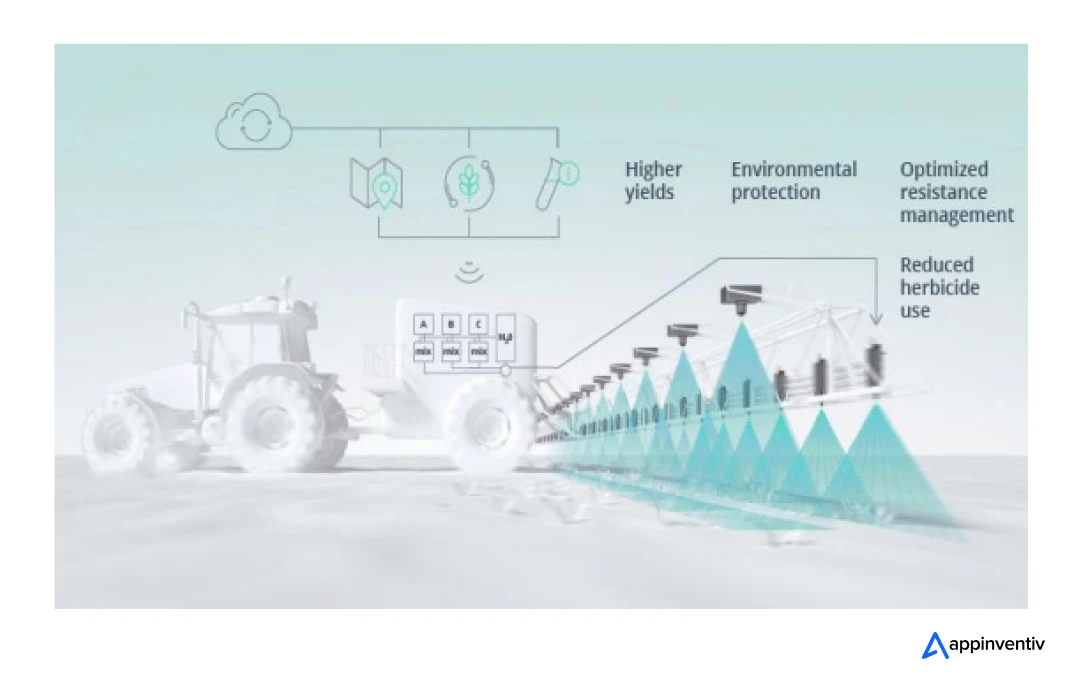
Transforms Agricultural Supply Chains
Blockchain in agriculture isn’t the only disruptive technology reshaping the industry; AI in agriculture is also revolutionizing how produce moves from farms to markets by streamlining logistics, improving demand forecasting, and ensuring traceability. This creates more efficient supply chains and reduces food waste on a larger scale. Predicting market trends and consumer needs helps farmers align their production with demand. Furthermore, AI farming enhances transparency across the supply chain, building trust among consumers and stakeholders through accurate tracking of produce origins and quality.
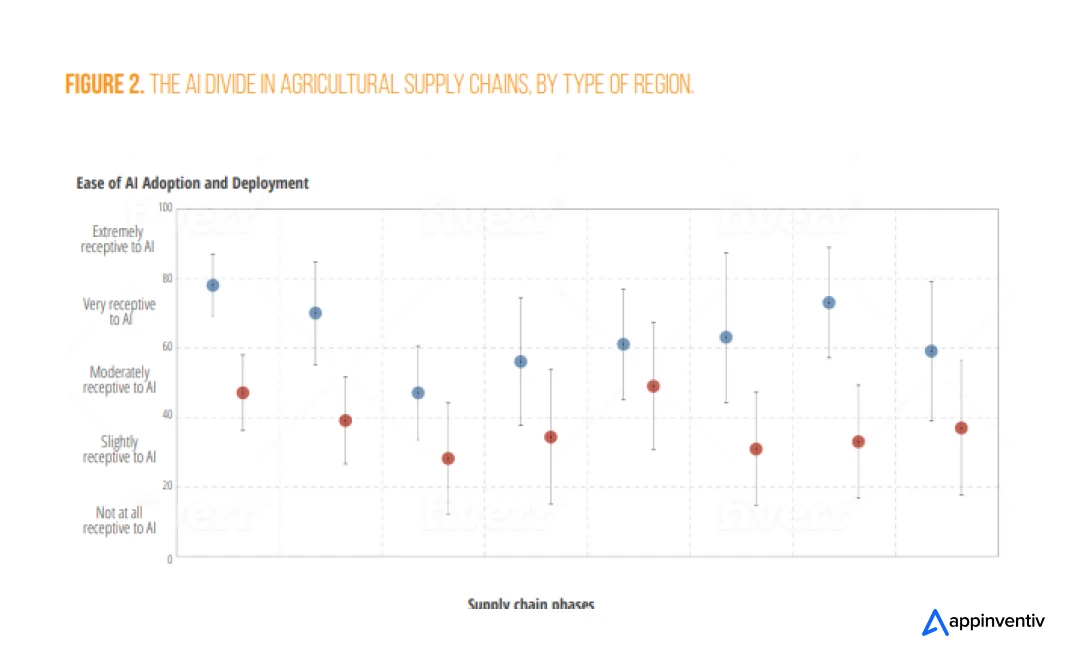
What are the Applications of Artificial Intelligence in Agriculture?
The adoption rate of artificial intelligence in the agriculture industry has changed the overall outcome of farming efforts, with a majority of startups in agriculture adopting AI-enabled approaches to increase the efficiency of agricultural production. Let’s dive deep into the various applications of AI in agriculture.
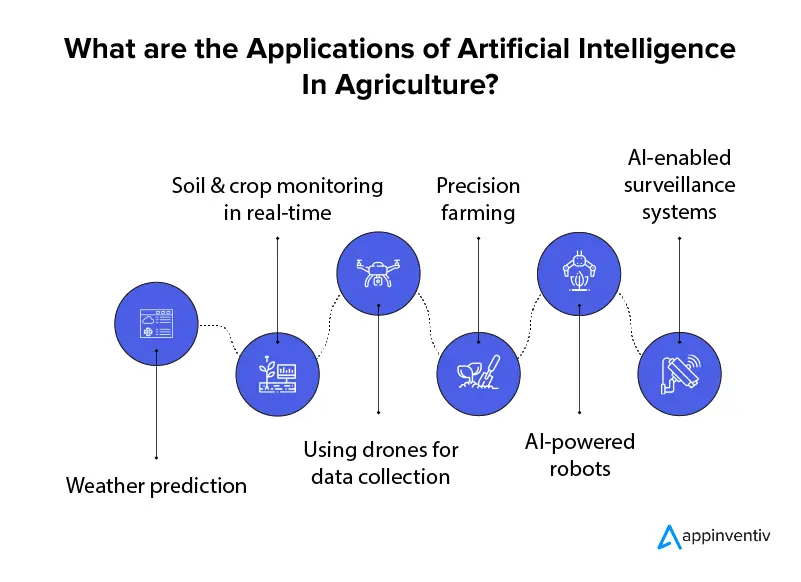
1. Weather Prediction
Over the years, we have experienced a drastic increase in pollution levels and unpredictable climatic conditions. The climate change has made it difficult for farmers to determine the right time for sowing seeds, and that’s where applications of AI in agriculture come into the picture. With the help of artificial intelligence, it is easy to gain insight into how weather, seasonal sunlight, wind speed, and rain will affect crop planting cycles. Weather forecasting will help farmers analyze and plan when the seeds should be sown.
2. Soil and Crop Monitoring in Real-Time
The role of AI in agriculture is revolutionizing soil and crop monitoring by providing real-time insights into critical parameters. AI in agriculture helps in soil and crop monitoring by providing real-time insights into critical parameters. Advanced sensors and drones collect data on soil moisture, nutrient levels, and crop health, which AI algorithms analyze to deliver actionable recommendations.
Machine learning models can detect anomalies such as pest infestations or nutrient deficiencies early, enabling timely interventions. This real-time monitoring ensures optimal resource utilization, improves yield quality, and reduces environmental impact, paving the way for smarter, more sustainable farming practices.
3. Using Drones for Data Collection
Thanks to AI and machine learning in agriculture, crop yield can be improved through real-time sensor data and visual analytics data from drones. Drones can provide real-time video surveillance that can analyze the growth patterns of crops.
On the other hand, smart sensors can provide data on moisture, fertilizer, and natural nutrient levels. That being said, we cannot deny the fact that drones are a reliable tool for capturing data on how specific fertilizers, watering patterns, and pesticide treatment methods are improving crop yields.
4. Precision Farming
The uses of AI in agriculture has resulted in applications that provide farmers with proper guidance regarding water management, crop rotation, timely harvesting, optimum planting, pest attacks, etc. With the help of machine learning algorithms and images captured by satellites and drones, AI use in agriculture helps predict weather conditions, manage nutrition effectively, and analyze crop sustainability seamlessly.
Precision farming is an approach where data inputs are utilized in precise amounts to achieve maximum crop yields. Farmers with smartphones and AI applications can get customized plans for their lands. With such result-driven IoT and AI-driven solutions, farmers can meet the requirements of our current and future world that include – increased food sustainably, growing production, and revenues without depleting any of our natural resources.
5. AI-Powered Robots
AI-powered companies are developing robots to perform multiple farming tasks. These robots are trained to control the excessive growth of weeds and harvest crops. They are also be trained to pick and pack crops. The goal is to automate such manual tasks and accomplish them at a much faster pace with higher volumes when compared to humans.
Bonus Read- Food Automation – How AI and Robotics are Transforming the Future of the Industry
6. AI-Enabled Surveillance Systems
In farming, AI enables using satellite images to compare them with past data to detect animal or human breaches. This reduces the risk of domestic or wild animals that can destroy crops. AI algorithms can also detect something as small as an insect, such as a locust, grasshopper, etc. Once an intrusion is detected, alerts are immediately sent to the farmers on their smartphones so that they can take the required precautions.
Real-World Examples of AI in Agriculture
AI in farming solutions plays a major role in offering assistance to farmers. If you want to know how AI is used in agriculture, then check out these prominent examples of artificial intelligence in agriculture:
Plantix
The Plantix app turns your smartphone into a mobile crop doctor that allows you to detect pests and diseases on crops within seconds accurately. Plantix serves as a complete solution for crop production and management.
MAAN
Appinventiv created an agri-education app, MAAN, meant to improve the nourishment conditions in the NMA region. The app allows the users to discuss and share agriculture-related articles and notes and share their experiences with their fellow users. The development team created a multilingual app like MAAN that could be used offline.
Agrobot
Agrobot robots can operate 24/7, which increases efficiency and optimizes the cost of precision to weed, hoe, and harvest. The Argobot E-series, with an advanced AI system, not only picks up the crops but can also identify the ripeness of the crop in the field. This is a prime example of AI in agriculture projects, showcasing how technology revolutionizes farming practices.
John Deere
With AI-powered autonomous tractors, John Deere is leading the way in agriculture. These tractors use GPS technology, sensors, and machine learning to plant, fertilize, and harvest.
The AI systems collect data on soil health, moisture levels, and crop growth, helping farmers make informed decisions. This reduces the need for manual labor, minimizes waste, and increases operational efficiency. John Deere’s equipment is designed to help farmers achieve higher productivity and more sustainable practices.
Essential AI Components Driving Agricultural Innovation
Here are some valuable AI components helping the agriculture industry grow by enhancing productivity, improving sustainability, and streamlining operations. These technologies are transforming traditional farming practices into efficient, data-driven processes.
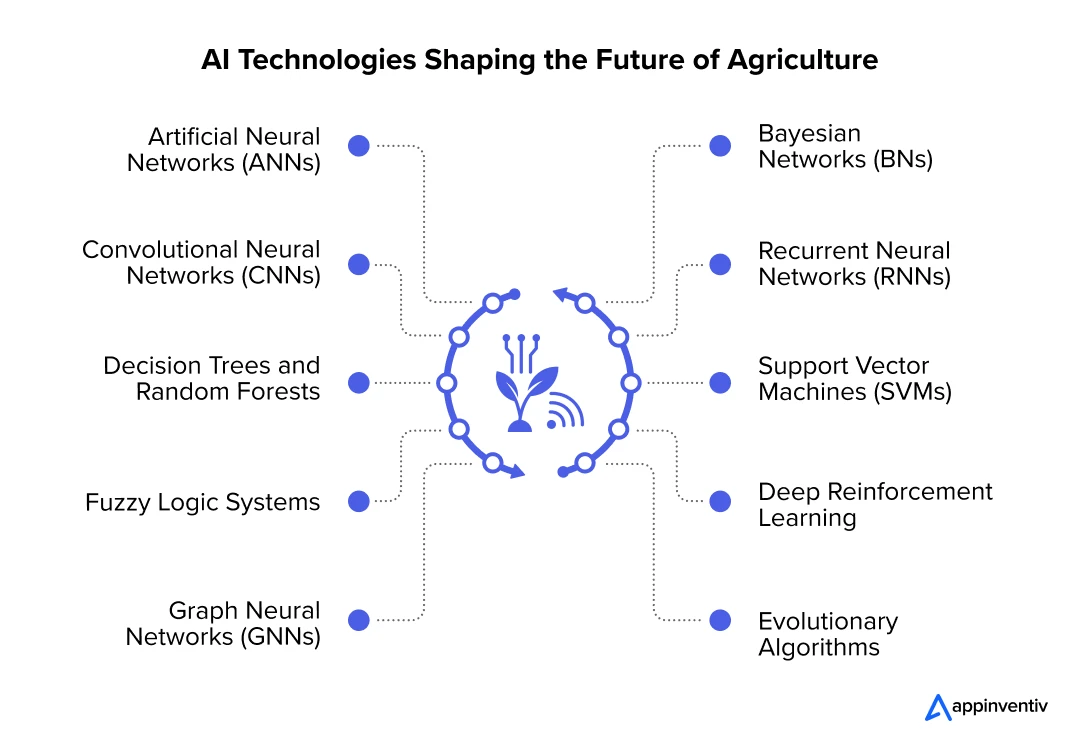
1. Artificial Neural Networks (ANNs)
Used to analyze complex, non-linear relationships in agricultural data such as soil conditions, weather patterns, and crop growth metrics. It enhances precision in yield prediction, disease detection, and resource allocation.
2. Bayesian Networks (BNs)
Models probabilistic dependencies between weather, pests, and crop yield to support decision-making under uncertainty. It improves risk assessment and enables informed farming strategies. This is one of the key use cases of AI in agriculture, as it helps farmers make data-driven decisions for better crop management.
3. Convolutional Neural Networks (CNNs)
Processes visual data from drones, cameras, or smartphones for crop disease detection, pest identification, and plant growth monitoring. It provides high accuracy in image-based diagnostics, reducing losses from undetected issues.
4. Recurrent Neural Networks (RNNs)
To forecast future outcomes, analyze time-series data, such as weather trends, soil moisture levels, and crop yields. It enables better planning of planting schedules and resource management.
5. Decision Trees and Random Forests
Classify soil types and assess fertility using structured data to support crop selection and fertilization plans. They enhance decision-making and improve crop productivity by tailoring farming strategies.
6. Support Vector Machines (SVMs)
Classify pests and diseases based on morphological features in images or sensor data. They provide precise targeting of pests and diseases, optimizing the use of resources. This is another prominent example demonstrating use cases of AI in agriculture, as it allows for efficient pest and disease management, reducing excessive pesticide use.
7. Fuzzy Logic Systems
Handle imprecise input data such as soil moisture levels or plant stress indices to make flexible irrigation decisions. They prevent overwatering or under-watering, ensuring optimal resource usage.
8. Deep Reinforcement Learning
Optimizes robotic and autonomous farming machinery by learning from real or simulated environments. It reduces labor costs and improves seeding, weeding, and harvesting efficiency.
9. Graph Neural Networks (GNNs)
The combination of Artificial intelligence and agriculture plays a crucial role in mapping and optimizing complex agricultural supply chain networks to improve logistics and reduce waste. They enhance the efficiency of product distribution and minimize losses in the supply chain, ensuring a more streamlined and sustainable agricultural process.
10. Evolutionary Algorithms
Simulate evolutionary processes to select optimal crop traits for breeding. They accelerate the development of climate-resilient and high-yield crop varieties, reducing dependency on traditional methods. This is a prime example of artificial intelligence and agriculture working together to enhance breeding techniques and improve crop performance.
Must-Have Agritech Solutions to Transform Your Business
AI technology in agriculture or, more precisely, agritech services helps ease your business’s complex manual operations with outstanding solutions. Grow the potential of your agri-business with the following agritech services.
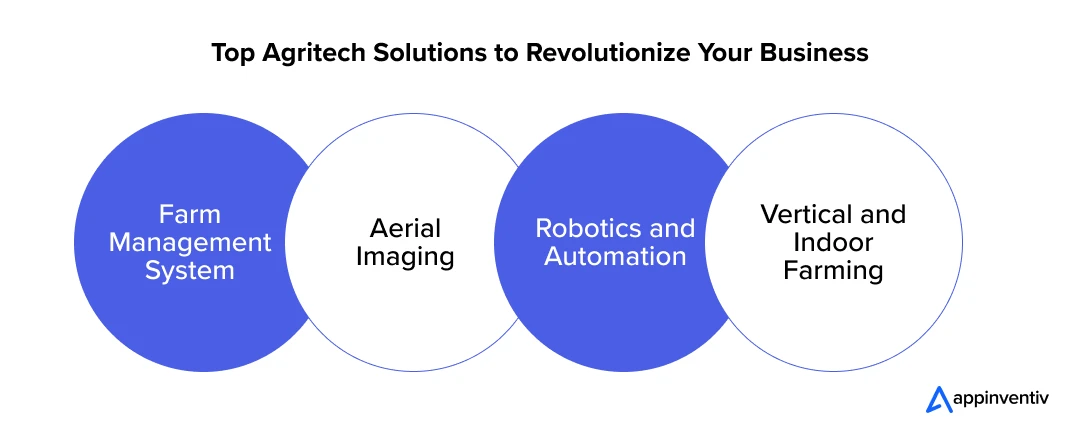
Farm Management System
A farm management system helps farmers make informed decisions, improve their farm production, and streamline their operations to gain more yields and profits.
Integrating data from various sources, such as weather forecasts, soil health, and market trends, allows farmers to optimize every aspect of their farm’s workflow. They also enable real-time tracking of field activities, reducing errors and improving overall farm management efficiency.
Aerial Imaging
With aerial imaging services, farmers can utilize aerial-captured images for advanced analysis of their crop yields and other agriculture-related factors that need to be addressed immediately.
By providing detailed visuals of crop health and growth patterns, aerial imaging enables farmers to identify issues like pest infestations, water stress, or nutrient deficiencies early on. These insights help in taking timely actions to improve crop productivity and prevent losses.
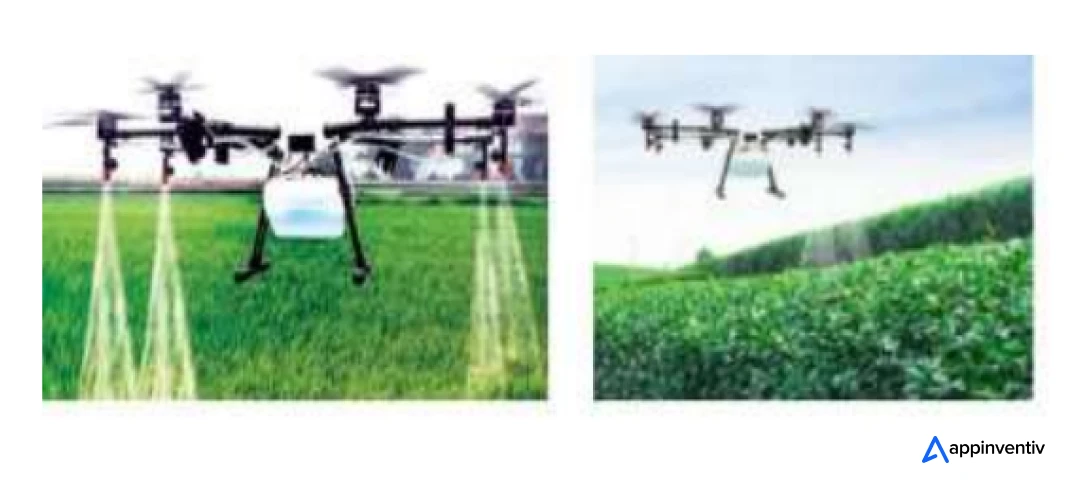
Robotics and Automation
The advanced robotic and automation software solutions and tools are simply the future of AI in agriculture. With these hi-tech solutions, the agricultural sector can ensure optimum efficiency with the least farming efforts.
Robotic systems can carry out repetitive tasks such as planting, weeding, and harvesting, saving farmers time and labor costs. Additionally, automation improves precision in tasks like pesticide spraying, leading to reduced chemical use and better environmental outcomes.
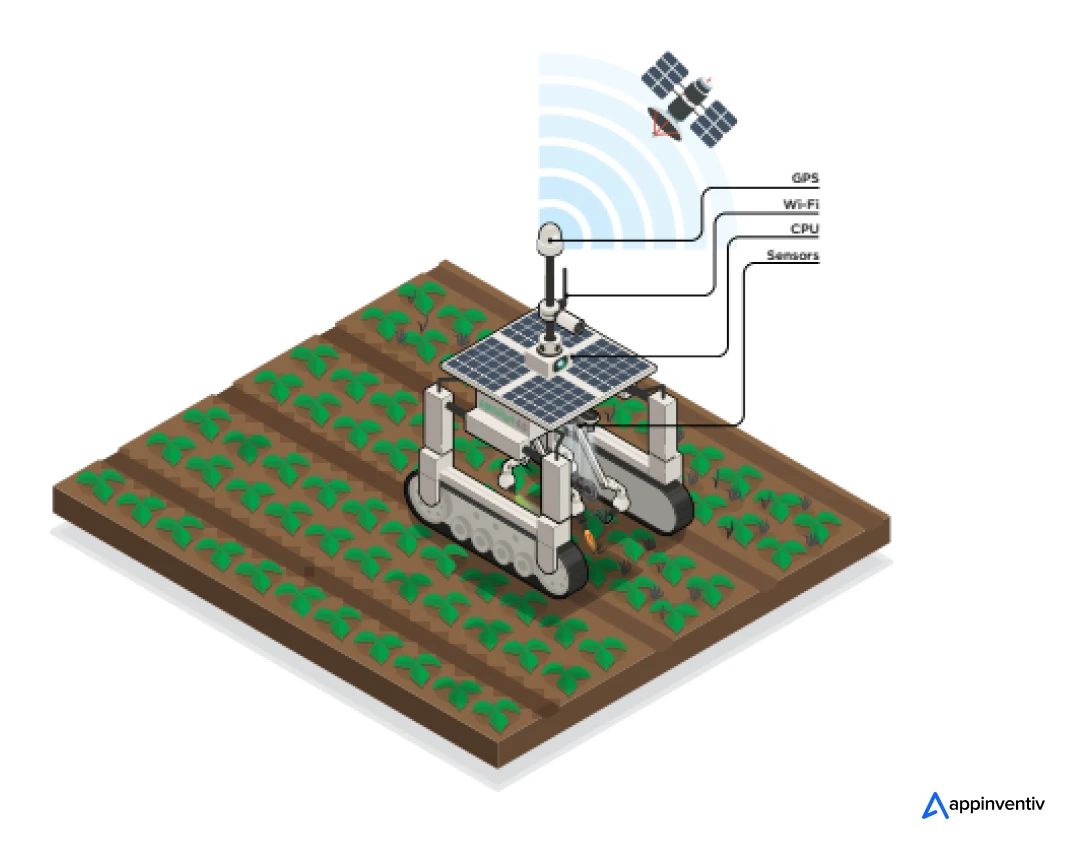
Vertical and Indoor Farming
With agriculture software solutions, farmers can smoothly manage their indoor and vertical farms in urban spaces by utilizing advanced tools for controlling indoor climate conditions and monitoring crop yields.
These solutions allow farmers to automate lighting, temperature, humidity, and irrigation systems year-round to create optimal growing conditions. This type of farming also conserves land space and resources while enabling high-density crop production, especially in urban settings where traditional farming is not feasible. This is a perfect example of AI and agriculture working together to optimize farming practices in modern environments.
Why your Business Needs Agriculture Custom Software Development
Agriculture custom software development can take your business to the next level. Let’s check out the reasons why the leading agriculture software companies go for agriculture software development services:
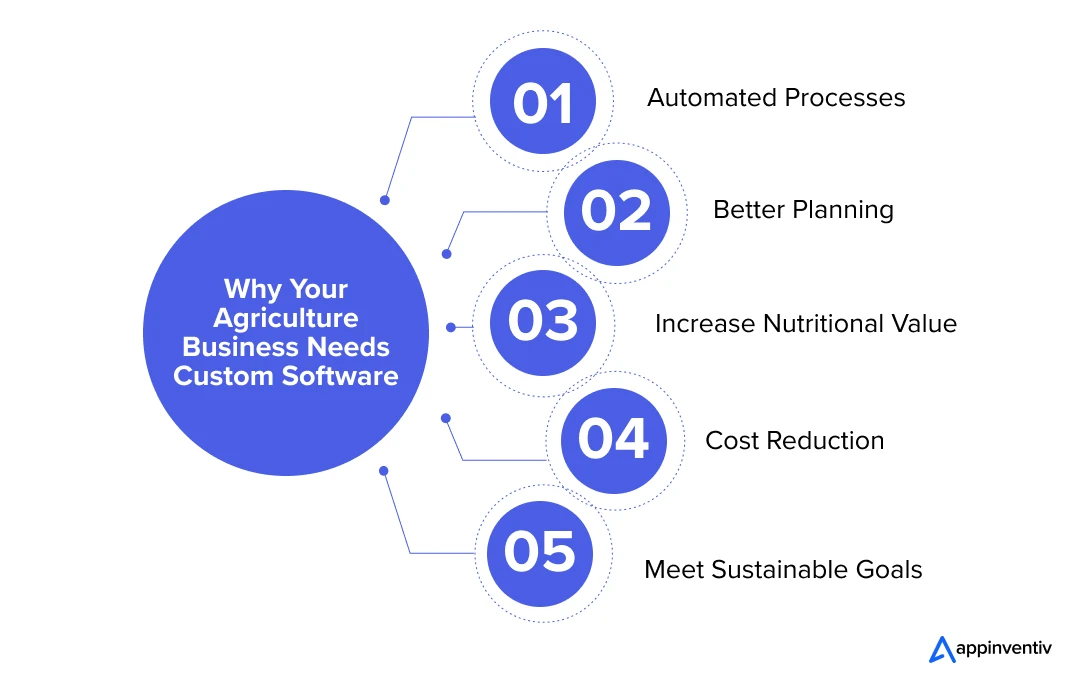
Automated Processes
With agriculture IT consulting firms like Appinventiv, you can now build your agriculture software solutions that would automate your agricultural workflows like livestock or field monitoring, pest management, irrigation management, and people coordination.
Better Planning
By utilizing the visualization and data analytics tools, you can access real-time insights that will help you make informed decisions with proactive planning for predicting stronger agri-based results.
Increase Nutritional Value
By developing a custom tracking system from a repeated agriculture software firm, you can receive complete data on your product in real-time. With this, you can adjust the treatment process of your crops and maximize the quality and quantity of your yields. This showcases the uses of AI in agriculture by enhancing decision-making and improving crop management.
Cost Reduction
Optimize utilization of resources and minimize waste along with maintaining a reasonable cost balance by integrating precision agriculture software from the best agriculture technology consulting firm like Appinventiv.
Meet Sustainable Goals
Now, you will be able to reach your sustainability goal with agriculture software consulting. Working with AI and agriculture becomes key as the need to cut carbon footprints and enhance food security grows. By combining advanced AI technologies with innovative agricultural practices, the agricultural sector’s digital frontier can be broken, fostering sustainability and efficiency in farming.
Step-by-Step Approach to Leveraging AI in Agriculture
Here’s a step-by-step approach to help you leverage artificial intelligence in agriculture, from identifying key challenges to implementing effective solutions. Following this guide can enhance productivity, reduce costs, and adopt innovative technologies to improve your farming operations.
Explore each step to see how AI can transform your agricultural practices.
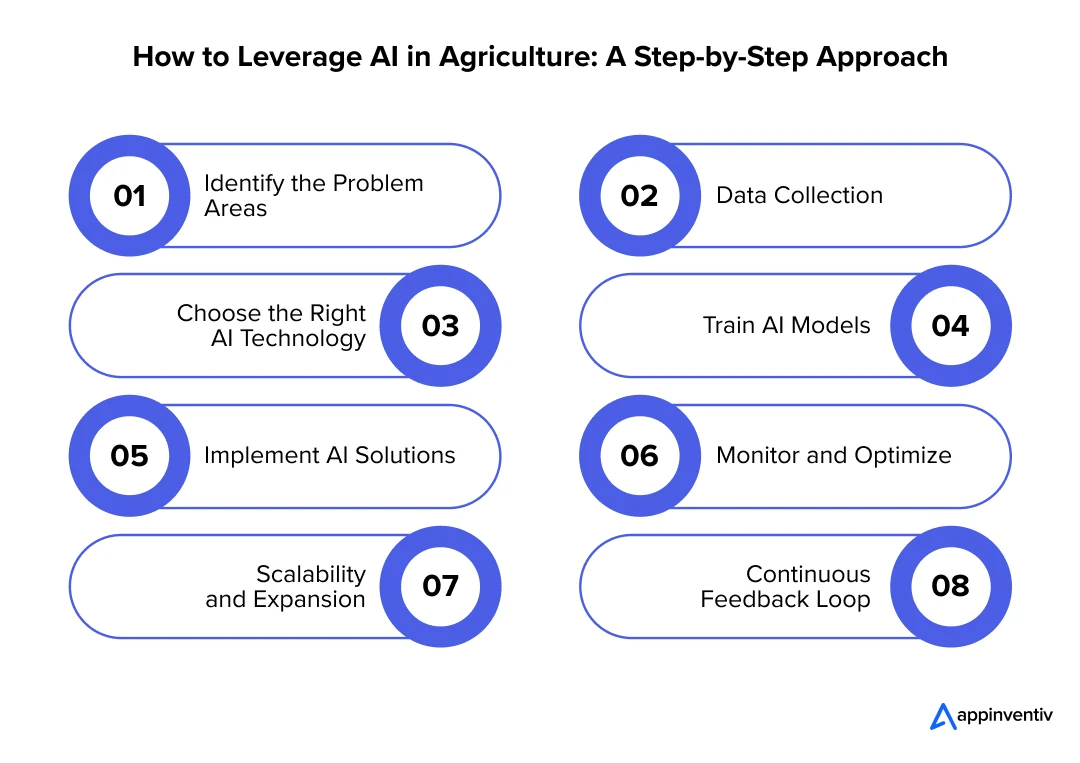
Identify the Problem Areas
Begin by analyzing your current agricultural practices and pinpointing specific pain points. Whether it’s inconsistent crop yields, water usage inefficiencies, or pest control, identifying key challenges helps focus AI efforts where they can drive the most impact. Prioritize areas with the highest potential for improvement through AI-driven solutions.
Data Collection
Data is the foundation of any successful AI application. Gather data from multiple sources like sensors, drones, weather stations, and satellite images. Collect real-time and historical data on soil health, crop conditions, irrigation, and weather patterns. The more comprehensive and accurate your data, the better your AI models can make informed decisions.
Choose the Right AI Technology
Selecting the right AI technology is crucial for solving the identified problems. Machine learning algorithms are great for predicting crop yields, while computer vision can help detect plant diseases. Natural language processing may also assist in processing reports and integrating diverse data sources. Choose technologies that align with the specific challenges you aim to address.
Train AI Models
AI models must be trained with your data to recognize patterns and improve decision-making capabilities. This step uses historical data and real-time insights to teach AI to predict trends, identify anomalies, and provide actionable recommendations. The more data the model processes, the better it becomes at making accurate predictions.
Implement AI Solutions
You can implement AI solutions in your daily farming operations with a trained AI model. Automated irrigation systems can optimize water usage, while AI-driven pest detection tools can reduce pesticide use. Artificial intelligence in agriculture can also help farmers with forecasting, maximizing the use of resources, and improving crop management practices.
Monitor and Optimize
Artificial intelligence for agriculture needs ongoing monitoring and optimization to ensure they continue performing well. Track the performance of your AI tools, measure their effectiveness in solving problems, and make adjustments where needed. As you collect more data, your AI models can be updated and refined, making the system even more efficient and effective.
Scalability and Expansion
Once AI solutions prove successful on a smaller scale, consider expanding their use to other aspects of your agricultural operations. This might involve scaling AI tools to additional fields, automating harvesting processes, or integrating AI across different stages of production. Expansion ensures you can reap the maximum benefits from AI across your entire operation.
Continuous Feedback Loop
AI in agriculture is not a one-and-done solution. Create a feedback loop where data and insights from the system are continuously gathered and analyzed. This feedback allows you to adjust and fine-tune your AI models, ensuring they effectively address evolving agricultural challenges and improve productivity. By following these steps, you can effectively harness the power of AI to increase efficiency, reduce costs, and maximize productivity in your farming practices, ultimately leading to a smarter and more sustainable agricultural operation.
Overcoming Agricultural Challenges with AI-Driven Solutions
Artificial intelligence for agriculture presents significant advantages and introduces complexities that require careful consideration. Implementing AI-driven solutions demands overcoming various hurdles that may arise during adoption and integration. However, with the right strategies in place, these challenges can be managed, enabling the agricultural sector to unlock the full potential of AI for improved productivity and sustainability.
1. Data Availability and Quality
Challenge: AI relies heavily on data, but the agriculture sector often faces gaps in high-quality, reliable farm data.
Solution: Implementing advanced sensors, satellite imagery, and IoT devices can help collect real-time data. Collaborations with tech firms or data-sharing initiatives can also bridge data gaps, ensuring the data used for AI models is comprehensive and accurate.
2. High Initial Investment
Challenge: Implementing AI solutions requires significant upfront investment in technology, training, and infrastructure.
Solution: Governments and agricultural organizations can provide grants or financial incentives. Businesses can adopt AI in stages, focusing on cost-effective solutions and scaling over time as they see ROI.
3. Lack of Technical Expertise
Challenge: Many farmers and agricultural businesses lack the technical skills to implement and use AI technology effectively.
Solution: Offering training programs, user-friendly AI platforms, and partnering with tech companies can empower workers. Additionally, consulting services or AI companies with agricultural expertise can guide businesses through the transition.
4. Integration with Existing Systems
Challenge: Many agricultural businesses still rely on traditional systems, making it difficult to integrate new AI technologies.
Solution: AI solutions can be designed to work alongside existing systems or implemented modularly, allowing businesses to upgrade gradually. Flexible, cloud-based platforms can also ease integration by providing scalability.
5. Data Privacy and Security Concerns
Challenge: With the massive amounts of data generated in agricultural AI systems, protecting this data from cyber threats and breaches is crucial.
Solution: Using robust encryption protocols, secure cloud storage, and establishing clear data privacy policies can address these concerns. Additionally, compliance with relevant regulations (like GDPR) ensures that data handling remains secure and transparent.
The Next Frontier in Agriculture: AI-Powered Innovations
The future of agriculture, powered by AI, can reshape how we think about food production, sustainability, and farming on a global scale. These AI-powered innovations will go beyond traditional methods, ushering in a new frontier where technology and nature coexist to address some of the most pressing challenges of modern agriculture.
AI-Enhanced Soil Health Diagnostics: AI will utilize advanced sensors and algorithms to generate real-time, detailed soil profiles. This will enable farmers to optimize nutrient management and reduce reliance on chemical inputs. By continuously monitoring soil health, AI will predict degradation early, allowing farmers to take preventative action.
AI-Powered Agroecology Models: AI will enable farmers to design farm landscapes that emulate natural ecosystems, promoting biodiversity while maintaining high productivity. By simulating and optimizing interactions between crops, soil, and surrounding environments, these AI models will help minimize the use of harmful chemicals and improve soil health. This approach will support more eco-friendly farming practices.
Quantum Computing for Crop Optimization: As quantum computing advances, it will allow for solving complex agricultural challenges at an unprecedented scale. AI combined with quantum computing will optimize crop growth conditions by simulating environmental variables and genetic factors in great detail. This could lead to breakthroughs in increasing crop yields and predicting market trends.
Revolutionize Your Agriculture with Appinventiv’s AI Solutions
Appinventiv is a leading innovator in AI development services, dedicated to revolutionizing the agricultural sector with intelligent solutions. As a prominent agriculture software development company, we build smart systems that optimize farming processes, improve crop management, and foster sustainable practices.
- Proven Excellence Across 3000+ Projects: Having completed over 3000 projects, we’ve demonstrated our ability to provide high-quality, results-driven solutions tailored to the unique challenges faced by various industries, including agriculture.
- A Global Workforce of 1600+ Professionals: Our team of 1600+ experts combines technical excellence with industry-specific knowledge to create innovative, scalable software solutions designed to meet the evolving needs of agriculture.
- A Seamless and Innovative Development Journey: Our client-first approach ensures transparent communication, timely delivery, and fully customized solutions that address the unique requirements of the agricultural landscape.
- Recognized for Innovation and Leadership: We’re proud to have received the ‘Tech Company of the Year award at the Times Business Awards 2023 and the Clutch Global Spring Award 2024, affirming our leadership in pushing the boundaries of technology.
Collaborate with Appinventiv to develop cutting-edge software solutions tailored to the agricultural industry, driving efficiency and sustainability in farming practices.
FAQs
Q. What are the advantages of artificial intelligence in agriculture?
A. There are numerous advantages of AI in agriculture:
- AI in agriculture is a more efficient way to produce, harvest and sell essential crops.
- Farmers can respond smartly to climate change by implementing approaches empowered by AI in climate change.
- AI emphasizes checking defective crops and pest identification, further improving crop health and yields.
- With the help of AI, it is impossible for intruders – wild or domestic animals and thieves to ruin your harvest.
- Crop management practices are improved with the help of technology. Farmers can produce higher crop yields with better quality by using fewer resources.
- AI technology reduces the labour challenge and automates manual work, accelerating the food transformation.
Q. How is AI used in agriculture?
A. AI is revolutionizing agriculture by improving efficiency and sustainability. Key uses of AI in agriculture include:
1. Precision Farming: AI analyzes data to optimize irrigation, fertilization, and pest control, enhancing crop yield and reducing waste.
2. Crop Monitoring and Disease Detection: AI detects early signs of diseases and pests, minimizing crop loss.
3. Autonomous Equipment: AI-powered tractors and drones perform tasks like planting, watering, and harvesting with minimal human involvement.
4. Predictive Analytics: AI forecasts crop yields and weather patterns, helping farmers make proactive decisions.
5. Supply Chain Optimization: AI improves delivery routes, reduces spoilage, and enhances farm-to-table tracking.
6. Livestock Monitoring: AI tracks animal health feeding patterns and detects diseases early.
7. Weed and Pest Control: AI robots target specific weeds and pests, reducing chemical use.
8. Climate Adaptation: AI helps farmers adjust practices to changing climate conditions.
Q. What are the various applications of AI in the agriculture sector?
A. AI in agriculture is currently helping farmers deliver efficient crop yields by utilizing data and devices like autonomous tractors, smart drones, soil sensors, and others. AI has found this application in the agricultural sector a long time back as it has increased the efficiency of agriculture. Let’s see various applications of AI in the agriculture sector:
- Weather prediction
- Crop and soil monitoring in real-time
- Leveraging drones for collecting data
- AI-powered robots
- AI-enabled surveillance system
Q. What are the effects of artificial intelligence in agriculture?
A. AI technology has a sizable impact on the entire agriculture industry worldwide. It has helped the sector grow in various ways. Here are some of them:
- AI tackles the problem of labor shortage
- Helps in the improvement of harvest
- Helps in whether data forecast
- Decreases the utilization of pesticides
- Detects plant diseases



How Technology in Agriculture Continues to Empower Farmers
The agriculture industry has seen multiple revolutions over the last 50 years. The advancements in agriculture, specially in machinery has, over time, expanded the speed, scale, and farm equipment productivity - leading to better land cultivation. Today, in the 21st century, agriculture has found itself in the center of yet another revolution. An agricultural technology…

How is Digital Technology Transforming Agri-food Systems?
Over the past fifty years, the agricultural sector has undergone a significant shift. Farm machinery has become vast, better, and more productive because of technological advances, enabling the more efficient cultivation of wider areas. Furthermore, vastly improved crops, irrigation, and chemicals have helped farmers raise yields. The next wave of digital transformation in agriculture technology…

Breaking the Digital Frontier with Mobile Apps for Agriculture
There was a time when technology and agriculture were at opposite ends of the value chain spectrum. Not anymore! Today, we have ample evidence to substantiate the role of a mobile application for agriculture and multiple reasons to prove its irrevocable dependency in farming operations. According to Statista, smart agriculture is expected to grow from…


















